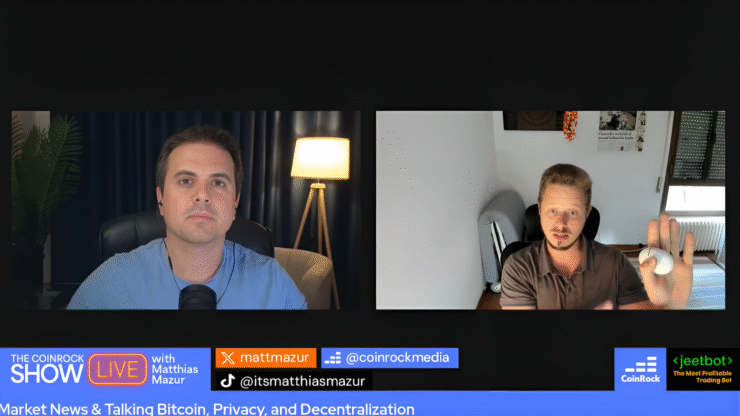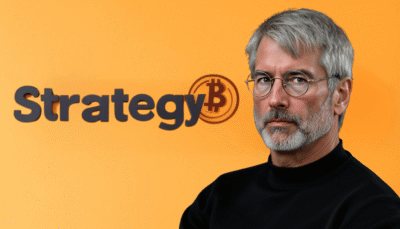Before welcoming this week’s guest, host Matthias kicked things off with a rundown of major crypto headlines that are shaping the broader market. In typical fashion, he touched on regulation, market structure, and the ever-persistent evolution of Bitcoin and its surrounding ecosystems.
The highlight? The U.S. Senate’s advancement of the Genius Act, a landmark bill aimed at bringing regulatory clarity to stablecoins. The bill marks a notable shift, especially given the Democrats’ historical resistance. Matthias connected the dots between stablecoin regulation and broader institutional adoption, noting how this legislative move could help unlock the doors for major funds, pension institutions, and banks still sitting on the sidelines.
“Overall, this is huge progress for the industry. This will give clarity,” he emphasized—particularly for risk-averse institutional players that require defined frameworks to allocate capital.
He also spotlighted Tether’s rising dominance, revealing that the stablecoin issuer has now surpassed Germany in U.S. Treasury holdings. With over $120 billion in T-bills, Tether is now the 19th largest global holder—surpassing even nation-states. This, Matthias argued, isn’t just symbolic. It’s a seismic shift in the financial power dynamics, with a crypto-native entity rising to sovereign-scale influence.
Finally, the episode addressed the Coinbase data leak scandal, in which customer support agents were bribed to leak highly sensitive data—including Social Security numbers, bank details, and transaction history. The breach has triggered a wave of lawsuits, once again bringing the KYC debate to the fore.
“This is very bad. It’s very bad because there will be a series of new new phishing attempts, of new threats towards people who KYC’d,” Matthias explained.
With that context, Matthias introduced the guest of the hour: Kilian Rausch, a veteran builder in the Bitcoin ecosystem and the CEO of Boltz—a non-custodial Bitcoin exchange leveraging the Lightning and Liquid networks.

From Mining Pools in China to Non-Custodial Innovation
Kilian’s Bitcoin story starts in Shanghai, where a chance encounter with Samson Mow led to a job at BTCC—one of the earliest crypto exchanges.
“I started working as a product manager for a Bitcoin mining pool without a clue what Bitcoin really was,” he confessed.
But the baptism by fire paid off. From mining farms in Sichuan to mobile wallet UX design, Kilian was all in.
“So China was the number one place of Bitcoin mining, all top three exchanges back then, OKCoin, BTCC and Huobi, and WorldChinese. So it was really the place to be.”
That early exposure seeded his fascination with user experience and decentralized architecture. By 2017, he had shifted gears to work on OpenDEX, an ambitious attempt at building a decentralized exchange on the Lightning Network.
“Back then, there was also something similar on Ethereum and a couple of other chains. So the idea was basically, wow, we built this first DEX that is not running on the chain directly, but it’s one layer higher.”
While that venture eventually shuttered, it birthed a side project that would survive the test of time: Boltz.
Boltz: Trustless Bitcoin Swaps Across Layers
Boltz was originally built to support liquidity management for OpenDEX. Today, it stands as a nimble, self-custodial bridge across multiple Bitcoin layers, including Lightning, Liquid, and Rootstock—with API integrations quietly powering mobile wallets like Aqua under the hood.
“Boltz started as a simple helper app to manage liquidity,” Kilian explained.
“So we needed some helper on the site that helps users to manage liquidity. And that’s actually how Boltz was born. It’s a thing that survived.”
But over time, it became clear there was product-market fit. As demand grew, Boltz pivoted to become the core focus of Kilian’s team.
One of the key technologies powering Boltz is atomic swaps, which allow users to trade assets across chains in a fully trustless manner.
“It’s all or nothing,” he said. “Either you get your funds, or the swap fails and you get your money back. No custody, no counterparty risk.”
Regulatory Strategy and the KYC Red Line
A major theme of the conversation was the role of regulation and compliance. Unlike most centralized exchanges, Boltz has taken a hardline stance: no KYC, ever. For Kilian, introducing friction in the form of identity uploads would kill the product.
“If we ever have to KYC our users, we’re dead,” he said bluntly.
That’s why Boltz is laser-focused on maintaining its non-custodial architecture, using cryptographic guarantees to stay outside the purview of money transmitter laws.
“We are a Bitcoin bridge and it has to work with a button click.”
In a strategic move, Boltz has incorporated in El Salvador, one of the most crypto-friendly jurisdictions globally.
“We could pay our taxes in Bitcoin. We don’t even have a bank account,” Kilian said.
“The entire company runs on Bitcoin.”
Beyond favorable regulation, he also praised the on-ground transformation in El Salvador—from militarized zones to thriving small businesses.
“The second thing we did is also when choosing our jurisdiction, we looked very carefully at these countries and it was exactly back then at the time when the US was going a little bit rogue.”

Why Bitcoin Layers Are the Future
The heart of Kilian’s thesis centers on Bitcoin’s emerging layer ecosystem. Far from being a maximalist purist, he sees enormous potential in EVM rollups, stablecoins, and cross-chain applications—all anchored to Bitcoin’s base layer.
“The vision is to become the non-custodial bridge between Bitcoin layers,” he explained.
“We’re not trying to be Uniswap or SushiSwap for altcoins. We just want to serve Bitcoin’s growing modularity.”
With integrations like Rootstock (an Ethereum-compatible Bitcoin sidechain) and upcoming layers like ARK and Spark (built by ex-Facebook’s David Marcus), the Bitcoin ecosystem is set to get more complex—and more powerful.
“We’re seeing the financial layer of the future form on Bitcoin,” Kilian added. “All the stuff that used to only exist on Ethereum—AMMs, stablecoins, DeFi—is now coming to Bitcoin.”
Stablecoins: The Coming Explosion
Kilian is also optimistic about the future of stablecoins, particularly their role in high-inflation economies and global settlement.
“It’s going to explode—100%,” he said. From local implementations like Lugano’s CHF-backed coin to USDT’s dominance in Argentina, stablecoins are becoming financial lifelines.
While he criticized the EU’s MiCA regulation for stifling innovation by restricting algorithmic and non-fully-backed stablecoins, he praised the U.S. for showing more flexibility—especially with the Genius Act paving the way.
“The EU is shooting themselves in the foot yet again by pushing innovators outside of the EU,”
Matthias and Kilian agreed. The pair further highlighted the fast tracked innovation first approach led by countries like El Salvador.
Final Thoughts and Bitcoin Price Prediction
To cap it off, Kilian offered a grounded take on Bitcoin’s future price trajectory. While some forecasts range as high as $500K, he pegged this cycle’s top at $150,000, noting that the traditional four-year halving cycle may no longer apply.
“You’ve never had BlackRock and trillion dollar funds looking at this asset class. Never. It has not happened. You’ve never seen US presidents openly bullish on the asset class. It has never happened. So it is fundamentally different in the type of holder and buyer. It is different.”
Where to Find Kilian Rausch
You can follow Kilian Rausch and explore more of his work through the following platforms:
- X (formerly Twitter): @kilrau
- Boltz Website: boltz.exchange
- API & Docs: docs.boltz.exchange




